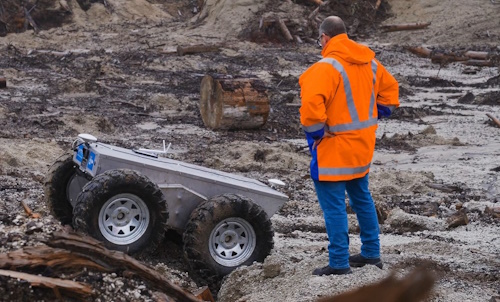
The prototype robot was put through its paces in a Tāupo forest.
Sometimes a research project leads to not just new technologies, but also to new ways of working.
That’s exactly what happened with a project to develop workforce robots for primary industries, which began in 2017.
It was funded for two years with a $2m grant from the Ministry of Business, Innovation and Employment’s National Science Challenge Science for Technological Innovations (SfTI) project. The interdisciplinary programme included scientists from Lincoln Agritech, Scion and the universities of Auckland, Canterbury, and Otago, as well as Massey University and Victoria University of Wellington.
They proposed developing self-learning robots that could work in harsh outdoor environments such as agriculture and forestry. These robots had to be able to detect and operate safely around human workers, as well as navigate rough terrain.
Called the “Robotic Spearhead” it was a science-led project, with industry guidance. Individual science teams worked on one aspect each before integrating their results into a full-fledged outdoor robot, says Armin Werner, Lincoln Agritech’s Precision Agriculture Group Manager, and the project’s Principle Investigator.
After two years the project won a three-year extension, focused on forestry, and working with the Lake Taupō Forest Trust.
“It was a better fit for what we were developing,” says Jaco Fourie, Lincoln Agritech’s Machine Vision Senior Scientist and Team Leader. “The industry was very receptive and put in a lot of time.”
The researchers were quite advanced in developing a robot they thought would be used as a self-guided mule to carry seedlings to the forestry workers planting them. But then the research approach turned on its head – from being science-led to industry-led.
“As scientists we have to discuss our ideas and use academic arguments about why they will work, for example, for the forestry sector,” says Armin. “But that strategy didn’t work for achieving the SfTI programme’s goals.”
“It’s not all that difficult for us to come up with a great idea and try to make the industry agree,” says Jaco. “But in reality, it’s better to work on something they actually want.
“We told them, ‘You’ve seen what technology we have developed and you’ve seen the ideas for it. We’re not going to tell you what we think the next step is – what do you want to see it do in the forest?’”
Lake Taupō Forestry Trust and Lake Rotoaira Forest Trust Manager Geoff Thorp says working with the project has been an opportunity to influence what future research will do.
“We see some of the techniques that they’re starting to develop as things that we know we’ll be able to use one way or the other.
“It’s been educational for us to see just how complex some of the challenges are that the researchers face in terms of automation and robotics.”
The project has now been funded for another 18 months, focusing on commercialising some of the technology developed.
The follow-up project will build and commercialise the manoeuvring control system for a robot that will, almost automatically, lay and maintain forest tracks by shedding the understorey. This control system could later be modified to be used in other outdoor robots.


